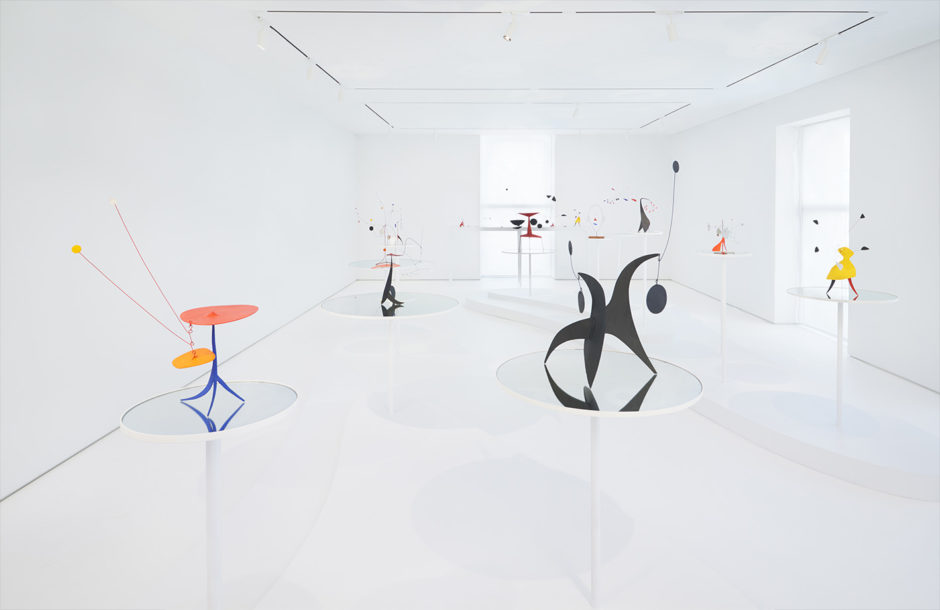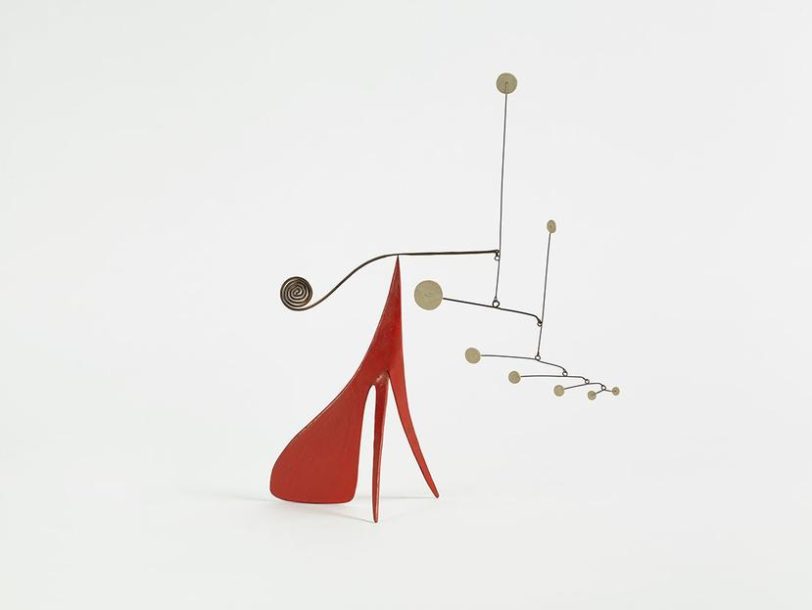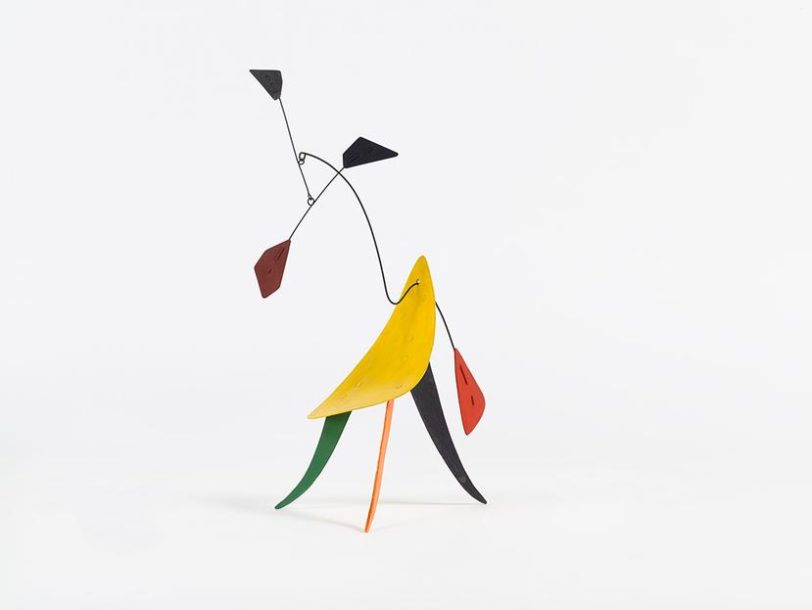
Alexander Calder
Alexander Calder
Alexander Calder was born in 1898 to artist parents—his father was a sculptor and his mother was a painter. While living in Pasadena in 1906 amidst the flourishing Arts and Crafts Movement, Calder was given his first tools and a workshop where he made toys and jewelry for his sister’s dolls. In his twenties, Calder moved to New York and studied at the Art Students League where he produced paintings congruous with the Ashcan aesthetic. He worked concurrently at the National Police Gazette, illustrating sporting events and the Ringling Bros. and Barnum & Bailey Circus. During this period, he commonly used sheet metal and wire for sculptures and other projects.
Soon after moving to Paris in 1926, Calder created Cirque Calder (1926–31). Made of wire and a spectrum of found materials, Cirque was a work of performance art that gained Calder an introduction to the Parisian avant-garde. Calder continued to explore his invention of wire sculpture, whereby he “drew” with wire in three dimensions portraits of friends, animals, circus themes, and personalities of the day. Calder called these figurative wire works “objects” as opposed to “sculpture” to signify his decisive break from the solidity of clay, bronze, and marble.
In the fall of 1931, a radical shift in Calder’s artistic career occurred when he created kinetic abstract sculpture and gave form to an entirely new type of art. The earliest of these objects moved by systems of motors, and were dubbed “mobiles” by Marcel Duchamp—in French, “mobile” ingeniously refers to both “motion” and “motive.” Calder soon turned away from the motorized compositions of his earliest mobiles, developing works that respond to air currents, light, humidity, and human interaction. He also created stationary abstract works that Jean Arp dubbed “stabiles.”
In 1937, Calder completed Devil Fish, his first stabile enlarged from a model. He received two important commissions: Mercury Fountain for the Spanish pavilion at the 1937 Paris World’s Fair, and Lobster Trap and Fish Tail for the main stairwell of the new Museum of Modern Art building in New York in 1939. His earliest retrospective was held at the George Walter Vincent Smith Gallery in Springfield, Massachusetts, in 1938. Another retrospective followed in 1943 at the Museum of Modern Art in New York, curated by James Johnson Sweeney and Duchamp. At that time, Calder was the youngest artist ever to whom the museum had dedicated a full-career survey, which was so popular that it was extended into 1944.
In the decades following World War II, Calder gained international distinction. In 1946, he had a major show at Galerie Louis Carré in Paris for which Jean-Paul Sartre wrote a seminal essay. He made the first of three extended trips to Brazil in 1948, where he held highly successful exhibitions in Rio de Janeiro and São Paulo. In 1952, he accepted the commission for Acoustic Ceiling (1954) for the Aula Magna auditorium at the Universidad Central de Venezuela. That same year, Calder represented the United States at the Venice Biennale, winning the Grand Prize for sculpture.
During a yearlong stay in Aix-en-Provence in 1953, Calder executed the first group of large-scale outdoor works and concentrated on painting gouaches. In 1954 and 1955, he visited the Middle East, India, and South America, with trips to Paris in between, resulting in an astonishing output and range of work. Calder soon turned his attention to commissions both at home and abroad, producing such recognizable works as .125 (1957), a mobile hung in John F. Kennedy Airport in New York, and Spirale (1958), a major commission for UNESCO in Paris. In Italy, Calder created Teodelapio, a stabile over fifty-eight feet tall, for the 1962 Spoleto Festival.
In 1963, Calder completed the construction of a large studio overlooking the Indre Valley in Saché, France. With the assistance of a full-scale, industrial ironworks, he began to fabricate monumental works and devoted much of his later working years to public commissions. Some of his most important projects include Trois disques for the 1967 exposition in Montreal; El Sol Rojo for the 1968 Mexico City Olympic Games; and La Grande vitesse for Grand Rapids, Michigan, in 1969. Major retrospectives of Calder's work were held at the Guggenheim Museum in New York (1964); The Museum of Fine Arts, Houston (1964); Musée National d'Art Moderne, Paris (1965); Fondation Maeght in Saint-Paul-de-Vence, France (1969); and the Whitney Museum of American Art, New York (1976). Calder died in New York in 1976 at the age of seventy-eight.
Selected Works
Video
Calder / Kelly
November 6, 2018
Exhibitions
Eternal Seasons: Part II 春華秋實:第二篇章
Hong Kong
April 28 - May 31, 2021
Alexander CalderCalder / Kelly
New York
November 9, 2018 - January 9, 2019
Alexander CalderAlexander Calder: PRIMARY MOTIONS
London
April 29 - September 1, 2015
Alexander CalderAlexander Calder: MULTUM IN PARVO
New York
April 22 - June 13, 2015
Alexander CalderCalder: The Complete Bronzes
New York
October 25, 2012 - February 9, 2013
Alexander CalderAlexander Calder
Los Angeles
April 27 - June 16, 2012
Alexander CalderTanguy Calder: Between Surrealism and Abstraction
New York
April 21 - July 9, 2010
Museum Exhibitions
Musicircus: Masterpieces from the Centre Pompidou Collection
April 20 - July 17, 2017
Above, Before, & After
May 7 - June 18, 2017
Alexander Calder: Motion Lab
May 14 - September 10, 2017
Calder: Hypermobility
June 9 - October 23, 2017
Publications
Selected Press
Wallpaper | Dear Calder, dear Kelly: the friendship of two great artists a generation apart
November 23, 2018
The New York Times T Magazine | A Rare Look at the Letters Between Two Art World Giants
November 9, 2018
Vulture | 49 Must-See Art Shows Opening This Fall From Daniel Arsham, Carmen Herrera, Irving Penn, and more
September 6, 2018
Artforum | Alexander Calder
September 1, 2015
Modern Painters | Reviews in Brief: New York - Alexander Calder
July 1, 2015
The New York Times | Review: Alexander Calder’s Intimate, Encompassing ‘Multum in Parvo’
June 4, 2015
Modern Decoration | Alexander Calder: Multum in Parvo
June 1, 2015
Cultured | Poetry in Motion
May 12, 2015
Financial Times | Critics' Choice: Alexander Calder
May 2, 2015
Interior Design | a matter of perspective
May 2, 2015
WNYC | Calder's Tiny Mobiles, Presented by a Flashy Architect
April 25, 2015
Wallpaper | Small Fortunes: Alexander Calder's miniature marvels on display at Dominique Lévy gallery
April 23, 2015
Art in America | Alexander Calder. MULTUM IN PARVO
April 23, 2015
T Magazine | A New Exhibition Examines Alexander Calder
April 22, 2015
art critical | Pas de Deux: Calder and Calatrava on Madison Avenue
April 21, 2015
Artnet | See Rare, Mesmerizing Alexander Calder Sculptures at Dominique Lévy
April 21, 2015
FT HOW TO SPEND IT | Calder and Calatrava at Dominique Lévy
April 15, 2015
Wall Street International Magazine | Alexander Calder. MULTUM IN PARVO
April 2, 2015
Architectural Digest | Small, intricate pieces by Alexander Calder on display at a New York exhibition
March 31, 2015
The New Yorker | Alexander Calder The Complete Bronzes
November 19, 2012
New York Times | Relics of a Sculptor’s Bronze Age
November 8, 2012
Wall Street Journal | In the Realms of Flight and Fantasy
June 12, 2010
At First Sight | Yves Tanguy & Alexander Calder
June 9, 2010
ArtNews | Yves Tanguy and Alexander Calder
May 31, 2010
NY Art Beat | The Museum Alternative
May 25, 2010
New York Observer | Art on the Avenue
May 17, 2010
New York Times | Shedding New Light on Old Friends
May 13, 2010
The New Yorker | Tanguy, Calder
May 3, 2010
More Information
Artists
Alexander Calder
Enrico Castellani
Chung Sang-Hwa
Francesco Clemente
Dan Colen
Willem de Kooning
Lucio Fontana
Gego
Yves Klein
Jutta Koether
Seung-taek Lee
Robert Motherwell
Senga Nengudi
Roman Opalka
Adrian Piper
Michelangelo Pistoletto
Carol Rama
Martial Raysse
Peter Regli
Germaine Richier
Karin Schneider
Joel Shapiro
Kazuo Shiraga
Pierre Soulages
Pat Steir
Tu Hongtao
Günther Uecker
Zao Wou-Ki
Specializing in Works By
- Terry Adkins
- Vincenzo Agnetti
- Carl Andre
- Diane Arbus
- Jean Arp
- Francis Bacon
- John Baldessari
- Jean-Michel Basquiat
- Alighiero Boetti
- Lee Bontecou
- Louise Bourgeois
- Mark Bradford
- Constantin Brancusi
- Cecily Brown
- Alberto Burri
- Sérgio Camargo
- Vija Celmins
- John Chamberlain
- Eduardo Chillida
- Lygia Clark
- George Condo
- Joseph Cornell
- Gino de Dominicis
- Nicolas de Staël
- Richard Diebenkorn
- PETER DOIG
- Jean Dubuffet
- Sam Francis
- Helen Frankenthaler
- Lucian Freud
- Alberto Giacometti
- Gilbert & George
- Johannes Girardoni
- Sonia Gomes
- Julio González
- Arshile Gorky
- Adolph Gottlieb
- Mark Grotjahn
- Philip Guston
- David Hammons
- Keith Haring
- Damien Hirst
- David Hockney
- Thomas Houseago
- Jasper Johns
- Donald Judd
- Ellsworth Kelly
- Anselm Kiefer
- Martin Kippenberger
- Franz Kline
- Jeff Koons
- Jannis Kounellis
- Lee Krasner
- Barbara Kruger
- Yayoi Kusama
- Gerald Laing
- Fernand Léger
- Roy Lichtenstein
- Liza Lou
- Tsuyoshi Maekawa
- René Magritte
- Piero Manzoni
- Brice Marden
- Agnes Martin
- Henri Matisse
- Fausto Melotti
- Joel Mesler
- Eleanore Mikus
- Joan Miró
- Joan Mitchell
- Amedeo Modigliani
- Piet Mondrian
- Paulo Monteiro
- Henry Moore
- François Morellet
- Bruce Nauman
- Barnett Newman
- Albert Oehlen
- Claes Oldenburg
- Francis Picabia
- Pablo Picasso
- Lari Pittman
- Sigmar Polke
- Jackson Pollock
- Richard Prince
- Robert Rauschenberg
- Charles Ray
- Ad Reinhardt
- Gerhard Richter
- Jean Paul Riopelle
- Mark Rothko
- Ed Ruscha
- Robert Ryman
- Salvatore Scarpitta
- Thomas Schütte
- Richard Serra
- Cindy Sherman
- Jeff Sonhouse
- Clyfford Still
- Rudolf Stingel
- Mark Tansey
- Mickalene Thomas
- James Turrell
- Cy Twombly
- Andy Warhol
- Tom Wesselmann
- Franz West
- Jonas Wood
- Christopher Wool













